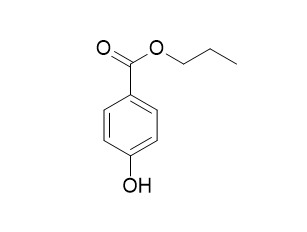Propyl paraben
Propyl paraben is a stable, non-volatile compound used as an antimicrobial preservative in foods, drugs and cosmetics for over 50 years.
Inquire / Order:
manager@chemfaces.com
Technical Inquiries:
service@chemfaces.com
Tel:
+86-27-84237783
Fax:
+86-27-84254680
Address:
1 Building, No. 83, CheCheng Rd., Wuhan Economic and Technological Development Zone, Wuhan, Hubei 430056, PRC
Providing storage is as stated on the product vial and the vial is kept tightly sealed, the product can be stored for up to
24 months(2-8C).
Wherever possible, you should prepare and use solutions on the same day. However, if you need to make up stock solutions in advance, we recommend that you store the solution as aliquots in tightly sealed vials at -20C. Generally, these will be useable for up to two weeks. Before use, and prior to opening the vial we recommend that you allow your product to equilibrate to room temperature for at least 1 hour.
Need more advice on solubility, usage and handling? Please email to: service@chemfaces.com
The packaging of the product may have turned upside down during transportation, resulting in the natural compounds adhering to the neck or cap of the vial. take the vial out of its packaging and gently shake to let the compounds fall to the bottom of the vial. for liquid products, centrifuge at 200-500 RPM to gather the liquid at the bottom of the vial. try to avoid loss or contamination during handling.
Front Nutr.2021, 8: 687851.
J Appl Microbiol.2024, 135(7):lxae180.
Cells.2022, 11(6):931.
Integr Med Res.2024, 13(1):101025.
Chin J Appl. Physiol.2019, 35(3):283-288
Preprints2024, 2085.v1
Oncotarget.2017, 8(53):90925-90947
Oncotarget.2017, 9(3):4161-4172
Int J Mol Sci.2018, 19(2)
Plant Cell Physiol.2023, 64(7):716-728.
Related and Featured Products
Journal of Antimicrobial Chemotherapy,2005,55(6):1013–1015.
Propyl paraben induces potassium efflux in Escherichia coli.[Reference:
WebLink]
Parabens are currently used as antibacterial preservatives in pharmaceutical, cosmetic and food products but there are no precise data concerning their activity on bacterial membranes.
METHODS AND RESULTS:
We analysed the cytoplasmic potassium release during Propyl paraben addition by using a selective electrode. Various conditions were assayed to investigate the bacterial paraben susceptibility. We compared the activity of Propyl paraben with the activities of colicin A and polymyxin B. Propyl paraben induced potassium efflux that was related to the porin expression in the bacterial outer membrane. In addition, the presence of spermine, previously described as an efficient OmpF channel-blocker, protected susceptible cells against paraben activity.
CONCLUSIONS:
Propyl paraben induced potassium release in susceptible Escherichia coli cells similar to that observed with polymyxin B. Moreover, this efflux depended on porin channel activity. This permeabilizing effect is probably related to antibacterial properties of paraben molecules.
Food & Chemical Toxicology, 2002, 40(12):0-1813.
Effects of propyl paraben on the male reproductive system.[Reference:
WebLink]
Parabens are p-hydroxybenzoic acid ester compounds widely used as preservatives in foods, cosmetics, toiletries and pharmaceuticals. These compounds exert a weak estrogenic activity as determined by in vitro estrogen receptor assay and in vivo uterotrophic assay. In a previous study, it was demonstrated by the present author that exposure of post-weaning mammals to butyl paraben adversely affects the secretion of testosterone and the function of the male reproductive system.
METHODS AND RESULTS:
In the present study, it is shown that Propyl paraben also adversely affects the hormonal secretion and the male reproductive functions. Propyl paraben was administered to 3-week-old rats which were divided into four groups of eight animals each, at doses of 0.00, 0.01, 0.10 and 1.00% with the AIN93G modified diet. At the end of 4 weeks, the rats were sacrificed by decapitation and the weights of testes, epididymides, prostates, seminal vesicles and preputial glands were determined. There were no treatment-related effects of Propyl paraben on the organ weights in any of the study groups. The cauda epididymal sperm reserves and concentrations decreased in a dose-dependent manner and the difference was significant at dose of 0.10% and above. Daily sperm production and its efficiency in the testis of all groups receiving Propyl paraben significantly decreased.
CONCLUSIONS:
The serum testosterone concentration decreased in a dose-dependent manner and the decrease was significant in the group that received the highest dose. The exposure level at which this effect was observed is the same as the upper-limit acceptable daily intake (10 mg/kg body weight/day) of parabens in the European Community and Japan.



